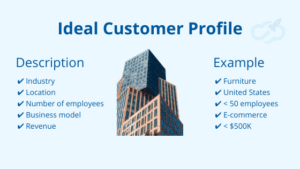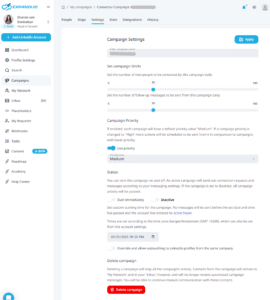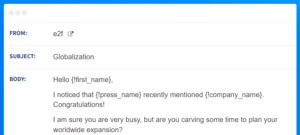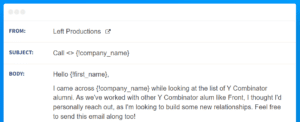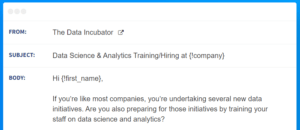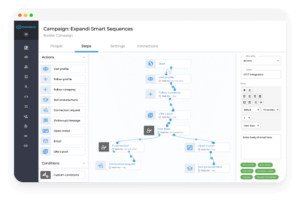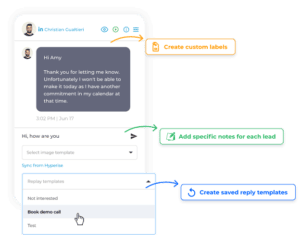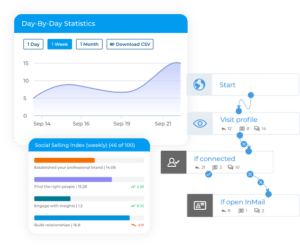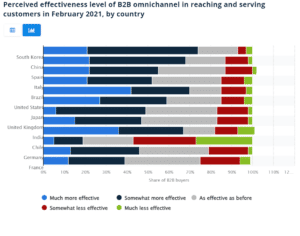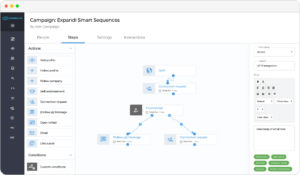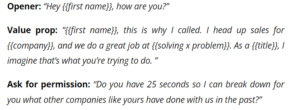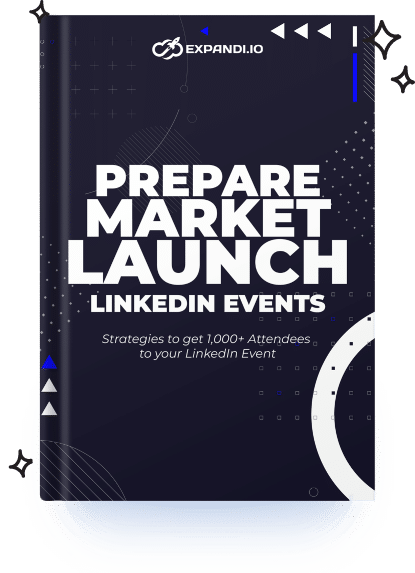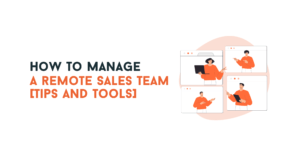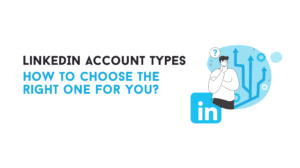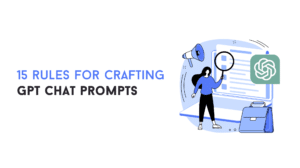Somewhere in the world, there are thousands (maybe even hundreds of thousands) of potential customers that would love your brand but haven’t heard of it yet.
Every day you don’t engage these customers is another day when…
- You miss out on potential revenue
- You miss out on building long-term customer-brand relationships
- Potential leads choose another brand because they haven’t heard of your brand
So, how do you capture the attention of these leads and show them what they are missing? The answer is lead generation — whether outbound or inbound. As outbound and inbound are massive topics, let’s focus on outbound for now.
Outbound lead generation isn’t as glamorous as top marketing trends like influencer marketing, short-form video content, virtual events, or experiential marketing.
But it is effective. If you want to expand your customer pool and build lasting relationships with leads, you need to use it.
To help you master outbound lead generation, this article will cover what it is and how to do it.
TL;DR:
- Outbound lead generation is the practice of finding and reaching leads who aren’t familiar with your brand.
- Outbound leads can give you fast access to new markets, increase your brand awareness, and help you shorten your sales cycle (in some situations that we’ll dive deeper into later). However, you must be careful in your approach: you must reach an audience who don’t know your brand and convince customers they have a problem to solve.
- The steps involved in outbound lead generation are:
- Goal and ICP identification
- Lead prospecting
- Campaign planning and set up
- Campaign execution
- Deal closing
- Approach evaluation
- Try these four outbound lead generation strategies:
- Cold emails
- LinkedIn outreach
- An omnichannel sales approach
- Cold calling
Table of Contents
Key terms defined…
Before we dive further into the science of outbound lead generation, let’s define some key terms:
Outbound leads
Outbound leads are prospects that you make contact with. Outbound leads aren’t familiar with your brand before your first interaction with them.
For example, say a SaaS salesperson finds the contact details of a company’s Chief Information Officer (CIO) and cold calls them to pitch their SaaS tool. The CIO is an outbound lead.
You can also call them cold leads or cold prospects.
Marketing Qualified Leads (MQLs) vs. Sales Qualified Leads (SQLs)
Marketing Qualified Leads (MQLs) are prospects who meet the criteria in your Ideal Customer Profile (ICP). Essentially: they would be a good customer on paper. A lead can also be considered an MQL when they show interest in your product. For example, when they download your lead magnet.
Sales Qualified Leads (SQLs) are prospects who are ready to talk numbers with your sales team. A lead can also be considered an SQL when they meet the following criteria:
- They belong to your ICP
- They have the problem you’re trying to solve
- They have enough budget for your product/services
- They are willing to buy a product like yours
For example, imagine a SaaS company posts marketing content on LinkedIn, and two CIOs respond. Nathan “likes” your post. Sarah clicks the post’s Call To Action (CTA) and books a call with your sales team. During this call, you discover she has the budget for your product and the approval to procure it.
Nathan is an MQL, and Sarah is an SQL.
Outbound lead generation
Outbound lead generation is the process of finding, qualifying, nurturing outbound leads, and reaching out to outbound leads.
We’ll cover some outbound lead generation strategies later in the “four outbound lead generation strategies” section.
Inbound lead generation vs. outbound lead generation
Here are a few key differences between inbound and outbound lead generation.
And here’s an example to help you understand these differences in practice.
Imagine this: a salesperson for a CRM tool is given a list of marketing managers. They call the first name on the list, and Mike answers. Mike hasn’t heard of the CRM tool before. This is outbound lead generation.
After the salesperson finishes with Mike, they get another call. The caller, Sally, found the CRM tool online and wants to ask a product question. This is inbound lead generation.
Read: “Inbound Marketing Funnel: What It Is and How to Use It for Your Business.”
What does outbound lead generation cover?
Outbound lead generation covers these marketing channels:
- Finding leads who fit your ICP on different platforms (databases, LinkedIn, Crunchbase, etc.)
- Cold calling and emailing
- LinkedIn outreach
Pros and cons of outbound lead generation
Pros:
- Fast access to new markets. Outbound lead generation is quite “on the ground,” so you can plant seeds in new markets quickly.
- Cost-effective. You don’t need to pay for ads.
- Gets you more deals. More deals mean higher revenue.
- You can build relationships with key people in your industry and high-ticket leads.
- Shorter sales cycle for some products and companies. If you target the right SQLs, you can turn them into customers very quickly. However, this benefit doesn’t always apply — the sales cycle will often be longer for high-ticket deals.
- You get immediate feedback on your marketing efforts. As sales reps speak with dozens of leads daily, they’ll learn what leads like and dislike very quickly.
Cons:
- You are trying to reach an audience who don’t know your brand well. Since consumers aren’t interested in your brand or content, many will simply ignore you. You must also build trust with consumers before you can sell to them, which can make outbound lead generation tricker than inbound lead generation.
- You must convince the leads they have a problem to solve. Many leads won’t realize they have a pain point at all, so they won’t be interested in a solution.
For example, let’s say you are trying to sell a CRM tool to a small business with no CRM practices. You must convince the business that the cost and time required for the CRM are worth the Return on Investment (ROI) before you can pitch your CRM tool.
Overview of the outbound lead generation process
The exact process depends on your customers, brand, goals, resources, and the market, but here are the rough steps sales reps* follow when they generate outbound leads.
*I’m using “sales reps” for brevity, but members of the marketing department also follow the outbound lead generation process.
Step 1. Identifying your goal and audience
First, sales reps set a Specific, Measurable, Achievable, Relevant, and Time-bound (SMART) goal and pinpoint their ICP.
ICPs include the following factors about leads:
- Industry
- Location
- Number of employees
- Business model
- Revenue
During the outreach process, ICPs help improve your focus, personalization, and performance. They also help you choose the right qualification channel and define your qualification criteria.
There are six steps involved in creating an ICP. They include:
- Analyzing your customers
- Choosing a market segment
- Selecting ten key customers
- Focus on discovering patterns
- Interview your customers
- Document your ICP
If you want more detail on these, read What is the Difference Between an Ideal Customer Profile vs Buyer Persona.
Step 2. Lead prospecting
Next, sales reps prospect for leads and create a base of potential leads to target.
Here are some places sales reps typically find leads (though this isn’t an exhaustive list):
- Online databases and lead generation software like UpLead, FindThatLead, Crunchbase, etc.
- Industry-related platforms and marketplaces like Slack (if they’re targeting Slack apps), Clutch (if they’re targeting agencies), GetLatka (if they’re targeting SaaS companies), Capterra, G2crowd, TrustPilot, and Yelp.
- Social media (LinkedIn, Facebook, etc.)
- Communities (Facebook groups, LinkedIn groups, newsletters, Slack communities, Discord servers, etc.)
- Hiring platforms
Lead qualification, the process of analyzing and ranking leads by their likelihood to convert, also occurs in this step.
Step 3. Plan your approach and set up your campaign
Then, sales reps brainstorm ways to initiate contact with leads. It’s important to get this first point of the contact right, as if it goes wrong, you’ll likely lose the lead.
If you were using a tool like Expandi for LinkedIn outreach, you would set it up during this step.
First, you would set up a campaign.
As part of this step, you would:
- Select the type of campaign (options include connector, messenger, open InMail, group, event invite, event participants, Gmail connector, recovery, inbound, and a campaign builder campaign)
- Name your campaign
- Choose the campaign template
- Add people
- Write a message
- Select when the campaign starts
Once you have created your campaign, you’ll be able to find it here:
Then, you would create limitations (the number of requests sent daily). The maximum number of limitations you can create is 100 per week.
Step 4. Run your campaign
Next, sales reps run their campaigns.
Step 5. Close deals
After the campaign is completed, sales reps nurture leads and close deals one by one.
Step 6. Evaluate your approach
Finally, sales reps reflect on what went well, what didn’t, and where they can improve for next time.
If you want to learn more about how sales reps access their lead generation efforts, read “How to measure lead generation – KPIs, ROI, and metrics to follow.”
4 Outbound lead generation strategies
Now that we’ve covered the basics of lead generation, let’s dive into four lead generation strategies.
#1. Send cold emails to a contact
Cold emails get a bad rep, but when done well, they can be highly effective for reaching out to contacts.
Take, for example, this cold message from our Try 10+ Best LinkedIn Connection Message Templates with Expandi post.
“Hi {first_name},
Your recent comment about {post-content-keyword} really struck a chord.
I tend to cover some great content on growth-hacking that you can use to increase your outreach strategy. If you want to check it out, I’ll be happy to send it your way.
Just let me know if it’s of any interest to you?”
This email is good because:
- It’s conversational but professional.
- It gives an elevator pitch of the author’s content without being overly promotional.
- It uses casual language like “really struck a chord” to grab attention.
- It gives the recipient a clear action plan (asking for content on outreach strategies).
Want to write a similarly good cold email? Try these tips:
- Craft a thought-provoking subject line. Here are four templates you could use:
- “Quick question, ((first name))”
- “Intro”
- “((first name)) – ((your name)) intro”
- “Some X ideas for you, ((first name))”
Or, you could steal this subject line from Gravity Video:
- Personalize your email. Address it to the recipient’s first name, include 1-2 sentences that link the email’s contents to the recipient, and ensure all content is relevant to them specifically.
Here’s how e2f personalized this email, for example:
A great way to personalize your email is by using an icebreaker. For example: “Just listened to your episode on X podcast, What you said to ((podcastHost)) about ((topic)) is mind-blowing. You changed my way of thinking.”
Effective Icebreakers are:
- Relevant to the prospect
- Relevant to the context of the email
- Sincere
- Focused on “non-obvious things” (i.e., saying, “I saw you’re working at Apple,” is less effective than saying, “I saw you switched from Microsoft to Apple, was it a hard decision to make?”
For example, here’s how Left Productions uses icebreakers:
- You have roughly three seconds to grab someone’s attention after they click your email, so use it. Forget bland introductions and start your email with a question, statistic, or argument that persuades the recipient to keep reading.
The Data Incubator, for example, went with questions:
- Add a human touch. Include jokes, play with words, and be conversational. You don’t want to seem like a robot.
This email from Ugi, for example, includes an adorable image of the author’s dog.
#2. Leverage LinkedIn for outreach
70% of B2B leads from social networks come from LinkedIn, so it’s a fantastic lead generation outreach and engagement strategy.
LinkedIn outreach is easy with Expandi. It allows you to:
- Choose your target audience. For example, you can target:
- Select people through LinkedIn Sales Navigator
- Event attendees
- Poll voters
- People who viewed your profile
- People who have engaged with a LinkedIn post
- Your own contacts
- Create smart sequences to automatically connect with leads. The following sequence, for example, has your account visit the lead’s profile, follow them, like a post, and send a connection request and an InMail.
- Follow-up with leads. You can customize when these follow-up messages are sent so that you don’t scare the lead away.
- Hyper-personalize your messaging. Personalization will help you stand out amongst the sea of similar messages.
- Use Smart Inbox. Smart Inbox helps you keep track of all your LinkedIn and email communication in one place so that you don’t miss responses from leads.
- Get metrics that help you assess the success of your LinkedIn outreach campaign. You can view these statistics for a day, week, or month.
- Manage multiple LinkedIn accounts from a single dashboard. You can also manage agency clients this way.
If you’d like to learn more about LinkedIn outreach, check out Our 10+ Best LinkedIn Connection Message Templates with Expandi.
#3. Adopt the omnichannel sales approach
An omnichannel approach gives leads a seamless experience across multiple channels like LinkedIn and email. According to data from marketers from seven countries, it is mostly “much more effective” or “somewhat more effective” in reaching B2B leads.
One in two ecommerce decision-makers in North America and Europe also believe omnichannel is very important.
Expandi can help you build omnichannel sales sequences through Smart Sequences.
For example, this smart sequence sends leads a connection request. If they don’t answer within five says, it then sends them an email to follow up.
You can customize your sales sequence using nine different actions:
- Visit profile
- Follow profile
- Follow company
- Skill endorsement
- Connection request
- Follow-up message
- Open InMail
- Like a post
There is no limit to how many steps you can add to your sequences, and you can also add a time delay between steps.
#4. Cold calls
A well-executed cold call starts a conversation that engages the recipient, introduces your solution, and brings the recipient on the path to purchase.
What does a well-executed cold call look like?
The National Account Executive for American Public Media Group, Kevin Gillman, uses this three-step approach:
Simple but effective.
Here are some tips to help you master your cold calls:
- Give the caller a reason to engage with you. For example, President of ATS Mobile and Purplegator Bob Bentz offers to help recipients with recruiting employees.
- Tailor the conversation around the recipient’s answers and let them steer. For example, CEO of JPM Partners Jessica Magoch takes a “choose your own adventure” approach:
- Do some research on the lead in advance and come to the call with value to provide. For example, the CMO of KiteDesk, Eric Quanstrom, seeks companies looking for Sales Development Representatives (SDRs). Then, he uses this template in the call:
Outbound lead generation best practices
The outbound sales process can go very right, but it can also go wrong easily.
Research on 400 sales reps from Sales Insights Lab shows that:
- 71.4% of respondents believe only 50% of their initial prospects “turn out to be a good fit.”
- 61% of sales reps think sales is harder than it was five years ago.
- Only 23.4% of sales reps exceeded their quota in 2021.
- 55% of respondents believe their budget was the first or second reason they didn’t close deals.
There is no way to guarantee your outbound lead generation strategy will be effective. But following best practices can increase your chances.
Here are ten such best practices:
- Use a detailed ICP.
- Use outbound lead generation tools. Assess these tools by their usability, integrations, pricing, and features/benefits so that you choose the right one.
- Align your sales and marketing teams.
- Make your strategy demand-driven.
- Make your outreach about your leads (not you). For example, personalize it to their industry, personality, job, location, current situation, and economic climate.
- Focus on prospects, provide value, and build relationships. Deal closing will come naturally later.
- Context is king. When reaching out via cold call, email, or message, make your content relevant.
- It’s better to target a few high-quality leads with hyper-personalized messages. You’ll get a better return than if you targeted many low-quality leads with limited personalization.
- A reply is the goal. Don’t aim to schedule a call or make a sale. Just aim for the reply, start a conversation, and turn the conversation into a meeting.
- Ask yourself, “would I reply to this email?” and “how would I respond/feel?” Read your emails out loud, and think objectively and critically. If you wouldn’t respond, why would your leads?
And, above all else, personalize your approach to each lead.
Final thoughts: Outbound lead generation
Effective outbound lead gen can give you fast access to new markets and increased brand awareness. It also helps you reach SQLs who would benefit from your product.
If you want results from outbound lead generation, we recommend these strategies:
- Cold emails and calls
- An omnichannel sales approach
- LinkedIn outreach
And if you’re opting for LinkedIn outreach, use Expandi.
You can set Expandi up in 15 minutes and get results in 24 hours.
Start your 7-day free Expandi trial now.

